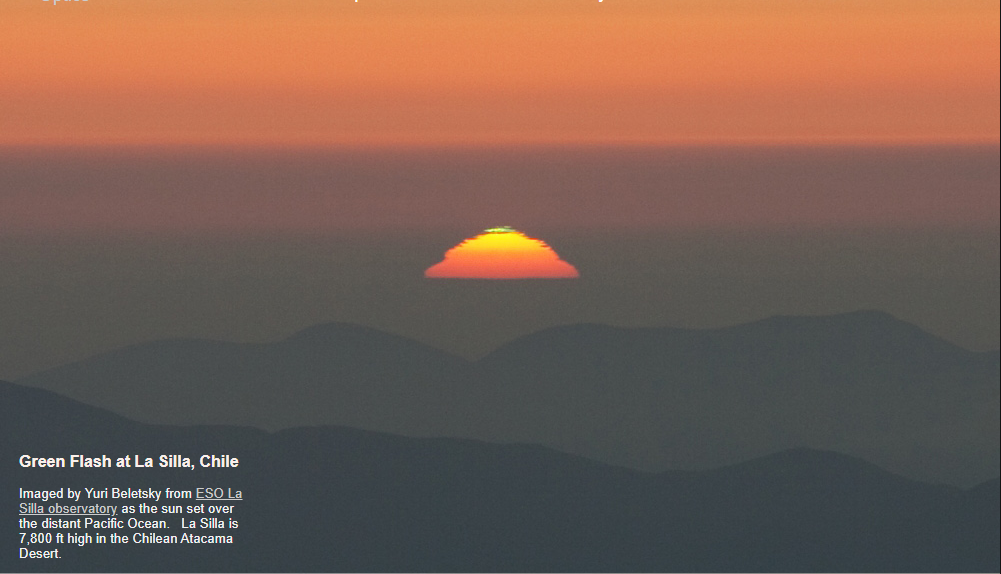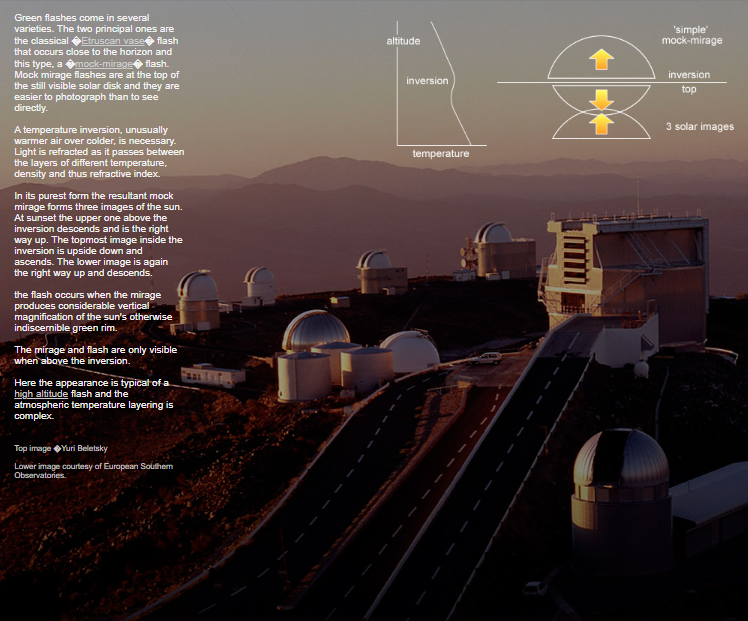Green Flash at La Silla
Green Flash at La Silla: A Phenomenon of Atmospheric Optics
The Green Flash at La Silla, Chile, is a captivating phenomenon in atmospheric optics that has intrigued observers for centuries. Located at an elevation of 7,800 ft in the arid Atacama Desert, the La Silla observatory offers a unique vantage point to witness this stunning event as the sun sets over the distant Pacific Ocean.
Green flashes manifest in various forms, with the two principal types being the classical "Etruscan vase" flash near the horizon and the "mock-mirage" flash, which occurs at the top of the solar disk. The latter type, although challenging to perceive directly, is more easily captured through photography.
To witness a mock-mirage green flash, a specific atmospheric condition known as a temperature inversion is required. This phenomenon involves warmer air overlaying colder air, resulting in a variation of temperature, density, and refractive index. As light passes through these layers, it becomes refracted, giving rise to unique optical effects.
In its purest manifestation, the mock mirage creates three distinct images of the sun. At sunset, the upper image situated above the inversion descends and appears upright. Simultaneously, the topmost image within the inversion appears inverted and ascends. Finally, the lower image once again descends and appears upright. The green flash occurs when the mirage amplifies the vertical magnification of the sun's otherwise imperceptible green rim.
It is important to note that both the mirage and the green flash are only visible when positioned above the inversion layer. This distinctive appearance observed at La Silla indicates a high-altitude flash, where the temperature layering within the atmosphere is intricate and complex.
Witnessing the Green Flash at La Silla offers an opportunity to experience a phenomenon that bridges art and science. The ethereal beauty of this event has captivated artists and astronomers alike, inspiring numerous artistic renditions and scientific investigations.
To further comprehend the complexities of the green flash, scientists have conducted extensive research to understand the underlying physics. By analyzing the atmospheric conditions, temperature profiles, and refractive properties, they have unraveled some of the mysteries surrounding this optical phenomenon.
The Green Flash at La Silla serves as a reminder of the intricate interplay between light and the atmosphere. As the sun dips below the horizon, its rays traverse the atmospheric layers, revealing a mesmerizing display of colors. The green flash, with its fleeting yet awe-inspiring presence, offers a glimpse into the hidden wonders of our atmosphere.
In conclusion, the Green Flash at La Silla represents a remarkable manifestation of atmospheric optics. This captivating phenomenon, observed from the vantage point of the La Silla observatory in Chile, showcases the intricate interplay between temperature inversions, refraction, and the magnification of light. Whether witnessed directly or captured through photography, the green flash at La Silla leaves observers in awe of the enchanting beauty of our natural world.

Green Flash at La Silla, Chile
Imaged by Yuri Beletsky from ESO La Silla observatory as the sun set over the distant Pacific Ocean. La Silla is 7,800 ft high in the Chilean Atacama Desert.

Green flashes come in several varieties. The two principal ones are the classical �Etruscan vase� flash that occurs close to the horizon and this type, a �mock-mirage� flash. Mock mirage flashes are at the top of the still visible solar disk and they are easier to photograph than to see directly.
A temperature inversion, unusually warmer air over colder, is necessary. Light is refracted as it passes between the layers of different temperature, density and thus refractive index.
In its purest form the resultant mock mirage forms three images of the sun. At sunset the upper one above the inversion descends and is the right way up. The topmost image inside the inversion is upside down and ascends. The lower image is again the right way up and descends.the flash occurs when the mirage produces considerable vertical magnification of the sun's otherwise indiscernible green rim.
The mirage and flash are only visible when above the inversion.
Here the appearance is typical of a high altitude flash and the atmospheric temperature layering is complex.
Top image �Yuri Beletsky
Lower image courtesy of European Southern Observatories.
Note: this article has been automatically converted from the old site and may not appear as intended. You can find the original article here.
Reference Atmospheric Optics
If you use any of the definitions, information, or data presented on Atmospheric Optics, please copy the link or reference below to properly credit us as the reference source. Thank you!
-
<a href="https://atoptics.co.uk/blog/green-flash-at-la-silla/">Green Flash at La Silla </a>
-
"Green Flash at La Silla ". Atmospheric Optics. Accessed on November 26, 2024. https://atoptics.co.uk/blog/green-flash-at-la-silla/.
-
"Green Flash at La Silla ". Atmospheric Optics, https://atoptics.co.uk/blog/green-flash-at-la-silla/. Accessed 26 November, 2024
-
Green Flash at La Silla . Atmospheric Optics. Retrieved from https://atoptics.co.uk/blog/green-flash-at-la-silla/.